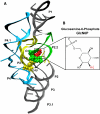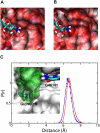Deciphering the role of glucosamine-6-phosphate in the riboswitch action of glmS ribozyme
- PMID: 20971809
- PMCID: PMC2995406
- DOI: 10.1261/rna.2334110
Deciphering the role of glucosamine-6-phosphate in the riboswitch action of glmS ribozyme
Abstract
The GlmS ribozyme is believed to exploit a general acid-base catalytic mechanism in the presence of glucosamine-6-phosphate (GlcN6P) to accelerate self-cleavage by approximately six orders of magnitude. The general acid and general base are not known, and the role of the GlcN6P cofactor is even less well understood. The amine group of GlcN6P has the ability to either accept or donate a proton and could therefore potentially act as an acid or a base. In order to decipher the role of GlcN6P in the self-cleavage of glmS, we have determined the preferred protonation state of the amine group in the wild-type and an inactive G40A mutant using molecular dynamics simulations and free energy calculations. Here we show that, upon binding of GlcN6P to wild-type glmS, the pK(a) of the amine moiety is altered by the active site environment, decreasing by about 2.2 from a solution pK(a) of about 8.2. On the other hand, we show that the pK(a) of the amine group slightly increases to about 8.4 upon binding to the G40A inactive mutant of glmS. These results suggest that GlcN6P acts as a general acid in the self-cleavage of glmS. Upon binding to glmS, GlcN6P can easily release a proton to the 5'-oxygen of G1 during self-cleavage of the backbone phosphodiester bond. However, in the G40A inactive mutant of glmS, the results suggest that the ability of GlcN6P to easily release its proton is diminished, in addition to the possible lack of G40 as an effective base.
Figures






Similar articles
-
The glmS ribozyme tunes the catalytically critical pK(a) of its coenzyme glucosamine-6-phosphate.J Am Chem Soc. 2011 Sep 14;133(36):14188-91. doi: 10.1021/ja205185g. Epub 2011 Aug 22. J Am Chem Soc. 2011. PMID: 21848325 Free PMC article.
-
glmS Riboswitch binding to the glucosamine-6-phosphate α-anomer shifts the pKa toward neutrality.Biochemistry. 2011 Aug 23;50(33):7236-42. doi: 10.1021/bi200471c. Epub 2011 Jul 27. Biochemistry. 2011. PMID: 21770472 Free PMC article.
-
Protonation states of the key active site residues and structural dynamics of the glmS riboswitch as revealed by molecular dynamics.J Phys Chem B. 2010 Jul 8;114(26):8701-12. doi: 10.1021/jp9109699. J Phys Chem B. 2010. PMID: 20536206 Free PMC article.
-
The glmS ribozyme: use of a small molecule coenzyme by a gene-regulatory RNA.Q Rev Biophys. 2010 Nov;43(4):423-47. doi: 10.1017/S0033583510000144. Epub 2010 Sep 8. Q Rev Biophys. 2010. PMID: 20822574 Free PMC article. Review.
-
Catalytic strategies of self-cleaving ribozymes.Acc Chem Res. 2008 Aug;41(8):1027-35. doi: 10.1021/ar800050c. Epub 2008 Jul 25. Acc Chem Res. 2008. PMID: 18652494 Review.
Cited by
-
An expanded collection and refined consensus model of glmS ribozymes.RNA. 2011 Apr;17(4):728-36. doi: 10.1261/rna.2590811. Epub 2011 Mar 2. RNA. 2011. PMID: 21367971 Free PMC article.
-
Structural Studies of the 3',3'-cGAMP Riboswitch Induced by Cognate and Noncognate Ligands Using Molecular Dynamics Simulation.Int J Mol Sci. 2018 Nov 9;19(11):3527. doi: 10.3390/ijms19113527. Int J Mol Sci. 2018. PMID: 30423927 Free PMC article.
-
The glmS ribozyme cofactor is a general acid-base catalyst.J Am Chem Soc. 2012 Nov 21;134(46):19043-9. doi: 10.1021/ja307021f. Epub 2012 Nov 9. J Am Chem Soc. 2012. PMID: 23113700 Free PMC article.
-
Mechanism and distribution of glmS ribozymes.Methods Mol Biol. 2012;848:113-29. doi: 10.1007/978-1-61779-545-9_8. Methods Mol Biol. 2012. PMID: 22315066 Free PMC article.
-
Divalent Metal Ion Activation of a Guanine General Base in the Hammerhead Ribozyme: Insights from Molecular Simulations.Biochemistry. 2017 Jun 20;56(24):2985-2994. doi: 10.1021/acs.biochem.6b01192. Epub 2017 Jun 12. Biochemistry. 2017. PMID: 28530384 Free PMC article.
References
-
- Allison S, Xin Y 2006. Electrokinetic transport of a spherical gel-layer model particle: Inclusion of charge regulation and application to polystyrene sulfonate. J Colloid Interface Sci 299: 977–988 - PubMed
-
- Anderson CF, Record MT 1995. Salt nucleic-acid interactions. Annu Rev Phys Chem 46: 657–700 - PubMed
Publication types
MeSH terms
Substances
LinkOut - more resources
Full Text Sources
